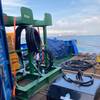Asian Panamax rates for dry bulk cargo are likely to inch up later this week on brisk demand for grain shipment after easing slightly in thin trade last week on the New Year holidays, Reuters reported. "The freight market is expected to gain momentum with the regional business returning to normal after the New Year holiday, and on expectation of active grain chartering before the Chinese New Year holiday starts," said a shipping broker in Seoul. The Lunar New Year falls on January 24. Offices in the Chinese community are likely to remain shut until as late as January 28 and the South Korean market will be closed from January 23 to 25. Panamax rates for the U.S. Gulf to Japan were indicated at $22.25-$22.50 a ton for February shipment, against a reported grain fixture at $22.50 with shipment for the first half of February last week, the broker said. Rates for March shipment were indicated at more than $23.00 on expectation of a seasonal pickup in vessel demand, he said. But ship owners were reluctant to strike deals for forward shipment on hopes of a further rise in vessel demand from late March, when South American grain exports begin, he added.
Timecharter rates for the U.S. Gulf to Japan were unchanged from last week at $11,000 a day plus $240,000 ballast bonus, said a Tokyo broker.
But timecharter rates for the Pacific round for modern Panamax vessels rose to about $12,500 a day from $12,250 last week, he said.
The rise in rates for the Pacific round reflected recent shifts for some grain loadings bound for Asia to the Pacific Northwest from the U.S. Gulf due to cold waves hampering vessel traffic in the Mississippi, another broker said.
"Some grain loadings bound for Asia from the U.S. Gulf were cancelled and moved to the Pacific Northwest," he said.
Brisk grain exports from Australia, along with continued mineral exports from Australia, China and Indonesia also helped boost the timecharter rates for the Pacific round, he said.
There has been a shortage in vessel supplies in the Pacific market since November due to slowing Japanese grain imports from the U.S. Gulf on the StarLink biotech corn controversy, while mineral exports to Europe from the Pacific region have been steady, he said.
Featured videos

Unlock Onboard Data Efficiencies

Tracking Foreign Vessels Working in the U.S. Jones Act Market

Inmarsat Enhances Service to Drive Digitalization
Subscribe for
Maritime Reporter E-News
Maritime Reporter E-News is the maritime industry's largest circulation and most authoritative ENews Service, delivered to your Email five times per week









